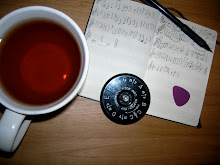(Note: There are spoilers below!)
Really, it was a fascinating spectacle. There was Nigel Planer as Vorgenson, the ringmaster.

He was the "driver" of the show, strutting to and from the corners of the stage and presenting his whiz-bang, literal or otherwise. (Somehow the FX and body language above seem more representative than a sharp image.) As at the proms but in a more 'characterized' way, he presents the features/scenes, built as thematic video montages (edits) put to music from the show, enhanced with monster action (and here with some significant FX).
Behind him stood Ben Foster, musical director of the 16-piece band (and at least 5 singers).


Despite the calm appearance in these photos, Ben and the band are (metaphorically) the 'engine' of the show. Ben's conducting is/was punctuated by energetic leaps, pogo-like jumping in place, kicks, and spins! The band is quite amazing; there are skilled soloists with a good sense of dramatic performance (as seen in the second image) and some obvious 'doubling' instrumentalists. (Kate Robertson was notably switching between flute, piccolo, sax, and clarinet all in one piece.)
To continue the metaphor, the monsters are the... paint job, chrome trim, tires, and cladding. (I suppose the special effects are the hubcaps, detail, and hood ornaments.) The monsters are absolutely necessary to the spectacle, because they carry much of the other half of the audience engagement equation. They appear on stage,

and (as at the Proms) they also go out in the aisles and interact with the people in their seats.

The interaction was obvious for those at close hand, and some monsters did stride beyond the bottom of the arena (the Smilers and apparently the Ood were also up in the tiered seating). But there are also aspects intended for the rest of the audience--because house video cameras are trained on the monsters' movements down the aisles. As you can hopefully make out from the picture of the nearby Cyberman below: there in the background, on the 50-foot screen, a live encounter happening elsewhere on the floor between Cybermen and a human is being displayed. Similar live house video was shown of the fish/vampire girls, the Silurian warriors, and others. To a far greater extent than was possible at the Proms, care was taken to show what was happening--even if the audience couldn't all be sat near the arena's monster 'highways,' we could at least see the action clearly on the live video put out to the big central screen.
 (By the way--like the musicians playing multiple instruments, the monster actors are also changing costumes many times during the show.)
(By the way--like the musicians playing multiple instruments, the monster actors are also changing costumes many times during the show.)Wait, what about the Doctor? Ah... the leather seats and convertible top, perhaps? The newly created and scripted video clips of the Doctor are handled really well (as at both Proms). The Doctor is of course the nominal focus of the show, so yes, his interaction is crucial. His link to the audience is well played and successful. (Though to cynical adults, maybe just a teensy bit Tinkerbell.) But since there are only a few (4 or 5?) of the new almost-interactive video scenes, a lot is left to the imagination and Vorgenson's narrative. Not a bad thing.
To conclude the automotive metaphors (with some relief!)--the music, Murray Gold's music, is the fuel. There are about 25 different tunes (plus a couple of extra runs through the TV theme and the 11th Doctor's theme, and the curtain-call ending tune). Among the new rock arrangements, some are more thoroughly re-interpretations, more identifiably different from their current TV versions. Bits reminiscent of the old TV movie theme were stirred into an introductory or 'prologue' version of the theme tune. When the theme got going more thoroughly, it was similar to the Proms-style, with a few Howell-era 'spangles' and such, but also perhaps with an extra dash of mid-1980s electronic/synth tone. The Judoon music is laugh-out-loud funny with the repeated vocal phrasing. (The Judoon piece was not their march from 'Smith and Jones'; it seemed to be a distant relative to the Futurekind/"All the Strange Strange Creatures" music.) Other arrangements seem to be more straightforward reductions for an ensemble. The 'Battle in the Sky' and 'Vampires of Venice' works may have been more percussion-heavy and with electric guitar, but their stage incarnations sound much like they do on TV.
The choice of music sometimes allows alert listeners advance hints as to the plot or story recap. In the first image below, the Ood's representative singer is performing the Song of Captivity. We (only) later hear about the Minimizer's entrapping function.

The use of "We Shall Fare Well" (with its vaguely unsettling lyrics) warns of danger, here in protesting the Spaceship UK's governance.

Most of all, Dalek music appears in the show before they themselves do, and a little in advance of Vorgenson's awareness. These are reasonably subtle hints (although most folks can recognize the various cues of Dalek music)--and they are not crucial for the story appreciation. They seem to be there just... to throw little seeds of doubt across Vorgenson's unreliable narrative, and as a bonus for fans.
It is a story--though the package, as others have blogged, is not burdened with a deep and complex plot. But they've built a... high-tech AND high-touch musical to keep children of all ages satisfied and seated for 100 minutes! And they're doing a really good job at it.
